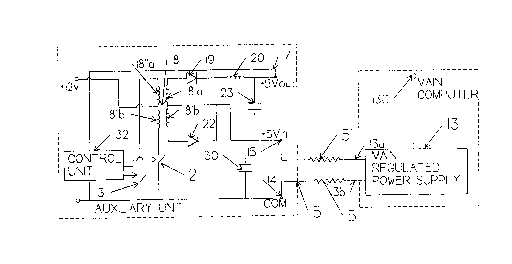Some of the information on this Web page has been provided by external sources. The Government of Canada is not responsible for the accuracy, reliability or currency of the information supplied by external sources. Users wishing to rely upon this information should consult directly with the source of the information. Content provided by external sources is not subject to official languages, privacy and accessibility requirements.
Any discrepancies in the text and image of the Claims and Abstract are due to differing posting times. Text of the Claims and Abstract are posted:
| (12) Patent: | (11) CA 2053382 |
|---|---|
| (54) English Title: | VOLTAGE BOOSTER |
| (54) French Title: | SURVOLTEUR |
| Status: | Term Expired - Post Grant Beyond Limit |
| (51) International Patent Classification (IPC): |
|
|---|---|
| (72) Inventors : |
|
| (73) Owners : |
|
| (71) Applicants : | |
| (74) Agent: | MARKS & CLERK |
| (74) Associate agent: | |
| (45) Issued: | 2000-04-18 |
| (22) Filed Date: | 1991-10-11 |
| (41) Open to Public Inspection: | 1993-04-12 |
| Examination requested: | 1997-07-08 |
| Availability of licence: | N/A |
| Dedicated to the Public: | N/A |
| (25) Language of filing: | English |
| Patent Cooperation Treaty (PCT): | No |
|---|
| (30) Application Priority Data: | None |
|---|
An auxiliary regulated power supply is described for
use in a system having a main load directly connected to a
main regulated power supply and an auxiliary load connected
to the main regulated power supply by a line in which a
voltage drop occurs. The auxiliary regulated power supply
comprises a pair of input terminals for connection to the
line, a pair of terminals far connection to a voltage
source, a pair of output terminals for connection to the
auxiliary load, a circuit for sensing the voltage at the
output terminals, and an arrangement for boosting the output
voltage at the output terminals from a secondary voltage
source as necessary to maintain it at a level appropriate
for the auxiliary load.
Note: Claims are shown in the official language in which they were submitted.
Note: Descriptions are shown in the official language in which they were submitted.

2024-08-01:As part of the Next Generation Patents (NGP) transition, the Canadian Patents Database (CPD) now contains a more detailed Event History, which replicates the Event Log of our new back-office solution.
Please note that "Inactive:" events refers to events no longer in use in our new back-office solution.
For a clearer understanding of the status of the application/patent presented on this page, the site Disclaimer , as well as the definitions for Patent , Event History , Maintenance Fee and Payment History should be consulted.
| Description | Date |
|---|---|
| Inactive: Expired (new Act pat) | 2011-10-11 |
| Letter Sent | 2010-03-31 |
| Letter Sent | 2009-04-29 |
| Letter Sent | 2007-10-19 |
| Letter Sent | 2007-10-19 |
| Inactive: IPC from MCD | 2006-03-11 |
| Inactive: IPC from MCD | 2006-03-11 |
| Inactive: IPC from MCD | 2006-03-11 |
| Letter Sent | 2005-09-09 |
| Letter Sent | 2005-08-15 |
| Letter Sent | 2005-08-15 |
| Letter Sent | 2001-06-13 |
| Letter Sent | 2001-06-08 |
| Inactive: Multiple transfers | 2001-04-24 |
| Letter Sent | 2000-10-03 |
| Grant by Issuance | 2000-04-18 |
| Inactive: Cover page published | 2000-04-17 |
| Pre-grant | 2000-01-13 |
| Inactive: Final fee received | 2000-01-13 |
| Letter Sent | 1999-10-26 |
| Notice of Allowance is Issued | 1999-10-26 |
| Notice of Allowance is Issued | 1999-10-26 |
| Inactive: Approved for allowance (AFA) | 1999-10-08 |
| Amendment Received - Voluntary Amendment | 1999-08-17 |
| Inactive: S.30(2) Rules - Examiner requisition | 1999-02-17 |
| Inactive: Multiple transfers | 1998-02-16 |
| Letter Sent | 1997-08-20 |
| Inactive: Status info is complete as of Log entry date | 1997-08-19 |
| Inactive: Application prosecuted on TS as of Log entry date | 1997-08-19 |
| All Requirements for Examination Determined Compliant | 1997-07-08 |
| Request for Examination Requirements Determined Compliant | 1997-07-08 |
| Application Published (Open to Public Inspection) | 1993-04-12 |
There is no abandonment history.
The last payment was received on
Note : If the full payment has not been received on or before the date indicated, a further fee may be required which may be one of the following
Please refer to the CIPO Patent Fees web page to see all current fee amounts.
Note: Records showing the ownership history in alphabetical order.
| Current Owners on Record |
|---|
| MITEL NETWORKS CORPORATION |
| Past Owners on Record |
|---|
| TOM LAVRISA |